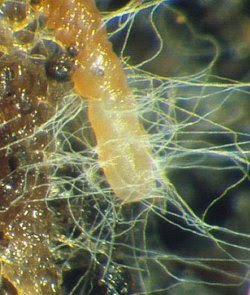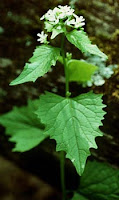Delicate complexity of soil
 Over 75% of the plants living on the earth benefit from symbiotic relationships with small, microscopic fungi attached to their roots. The fungi are referred to as micorrhiza (my-core-i-zuh). Though we usually can't see them - they are under ground and are very small - their beneficial effects on plants are real and substantial. One major benefit is an increase in delivery of phosphorus to the root system.
Over 75% of the plants living on the earth benefit from symbiotic relationships with small, microscopic fungi attached to their roots. The fungi are referred to as micorrhiza (my-core-i-zuh). Though we usually can't see them - they are under ground and are very small - their beneficial effects on plants are real and substantial. One major benefit is an increase in delivery of phosphorus to the root system.One of the less well attended presentations at last week's Native Plants in the Landscape conference at Millersville University in Pennsylvania was "Micorrhizal Fungi: Hidden Friends of Plants." Dr. Roger Tai Koide of Pennsylvania State University described recent research that clearly demonstrates the benefit of such relationships to most plants.
The fungi grow very small, even microscopic, filaments - called hyphae (hi-fee) - that extend from the roots of plants into surrounding soil. These filaments, in effect, function as extensions of a plant's roots, and can effectively expand the root's surface area thousands of times. The photo above shows the white hyphae extending our from a root.
Does a gardener need to know about micorrhiza? Probably not, if you measure value only in direct utilitarian terms. But there is an important lesson to be learned from this bit of knowledge: our environment is extraordinarily complex and we can easily disrupt it if we blunder forward in ignorance, without considering what we do not know. There is a delicately balanced, invisible ecosystem underground that demands respect, perhaps even reverence.
 Actually, there is one practical application for this knowledge, and there are probably many more. The highly invasive plant, garlic mustard (Alliaria petiolata), damages micorrhiza. Why this is remains a mystery. In addition to its ability to completely overwhelm native plant communities and to form a virtual monoculture over the ground surface, at least in North America, it has insidious underground effects, damaging the symbiotic relationships that benefit many other plant species... yet another reason to support efforts to eradicate garlic mustard from our environment.
Actually, there is one practical application for this knowledge, and there are probably many more. The highly invasive plant, garlic mustard (Alliaria petiolata), damages micorrhiza. Why this is remains a mystery. In addition to its ability to completely overwhelm native plant communities and to form a virtual monoculture over the ground surface, at least in North America, it has insidious underground effects, damaging the symbiotic relationships that benefit many other plant species... yet another reason to support efforts to eradicate garlic mustard from our environment.There is another mystery too. In its native European habitats, garlic mustard does not have this effect!
James Golden